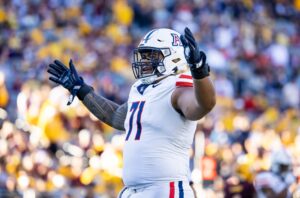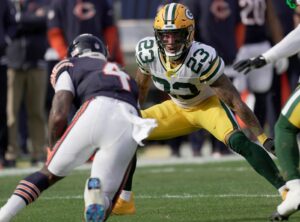If I was given one wish for the 2020 Fantasy Football season, it would be to properly handicap the RB1 opportunity share for every NFL team. That position is the most critical this season, with an overwhelming number of running backs being drafted in the first two rounds. When projecting the opportunity share for the upcoming season, it is important to include several different factors.
Projecting RB1 Opportunity Share For Each NFL Team
Most fantasy drafters simply examine the running back opportunity share based on past performance and if a new running back was added to the depth chart. Those factors are not nearly as important as how that running back performed last season in games they were healthy and received the majority of touches. Even if a reduced sample, it provides the best window into the potential opportunity share for the 2020 season.
For each team’s projected starting running back, I listed the opportunity share from the 2019 season in games they started and did not leave due to injury. For players that joined new teams (i.e Todd Gurley in Atlanta), I used the stats from last year’s primary starting running back (i.e. Devonta Freeman). While the skill set may not match perfectly, it gives us a strong projection of usage for 2020.
In this eight-part series, we will examine the projected lead running backs for each NFL division. Let’s examine with the AFC North.
Baltimore Ravens
2019 RB1: Mark Ingram
Games: 15
Rushes: 36.59 percent
Rushing Yards: 33.13 percent
Targets: 7.18 percent
Receptions: 9.35 percent
Receiving Yards: 7.59 percent
Touchdowns: 26.32 percent
2020 RB1: Mark Ingram
How worried are fantasy “experts” about JK Dobbins’ potential drain on Mark Ingram’s value?
The veteran just fell to 6.06 in a 12-team .5 PPR draft.
At that price, I could not resist.
— Brad Evans (@NoisyHuevos) May 4, 2020
Outlook: Ingram owners are nervous. His low 36.59 percent carry percentage was offset by Baltimore’s league-high 54.1 percent team run rate. Ingram must now contend with second-round pick J.K. Dobbins, who produced over 2,000 rushing yards and 23 touchdowns for Ohio State in 2019. Ingram’s passing game impact was minimal, ranking outside the Top 40 in both running back targets and receptions. He needs the Ravens to limit Lamar Jackson‘s red zone runs in the hopes of maintaining his superior touchdown efficiency. However, fantasy drafters have overcorrected for these concerns, currently ranking Ingram outside the Top 24 running backs in Best Ball ADP. The Dobbins impact is real, but barring significant touchdown regression, Ingram is a lock for an overall RB2 or better season.
Cincinnati Bengals
2019 RB: Joe Mixon
Games: 16
Rushes: 72.21 percent
Rushing Yards: 74.95 percent
Targets: 7.64 percent
Receptions: 9.83 percent
Receiving Yards: 7.19 percent
Touchdowns: 29.63 percent
2020 RB1: Joe Mixon
Thread on Joe Mixon pulling yards out of his ass in 2019: pic.twitter.com/HIMTpq9d5z
— Johnny Kinsley (@Brickwallblitz) June 19, 2020
Outlook: Mixon had an underrated ending to the fantasy season. Starting in Week 8, Mixon’s 883 rushing yards ranked second (Derrick Henry) at the position and he was sixth overall in running back fantasy points. Mixon’s limited (eight) touchdown production was a direct result of a Bengals team that ranked last in team touchdown rate (1.8 per game). Even with concerns playing with a rookie quarterback, first overall draft pick Joe Burrow should be an improvement over last season’s combination of Andy Dalton and Ryan Finley (18 touchdowns, 16 interceptions). Ranking fourth and eighth in positional rushing yards respectively the past two seasons, Mixon enjoys elite rushing volume at fantasy’s most important position.
Cleveland Browns
2019 RB: Nick Chubb
Games: 16
Rushes: 75.83 percent
Rushing Yards: 78.59 percent
Targets: 9.48 percent
Receptions: 11.32 percent
Receiving Yards: 7.23 percent
Touchdowns: 21.62 percent
2020 RB1: Nick Chubb
Nick Chubb = really, really good
Kareem Hunt = also really, really good
The Browns actually addressed their o-line this offseason and have the look of a post-hype sleeper entering 2020.
Both RBs are worth pursuing at their current ADPs: https://t.co/GufKIhTtsS
— Ian Hartitz (@Ihartitz) June 16, 2020
Outlook: Nick Chubb has the overall RB1 in his 2020 range of outcomes. Cleveland committed to improving their 23rd ranked offensive line with the signing of tackle Jack Conklin and drafting of Alabama tackle Jedrick Wills. The Browns’ unit is projected as the most improved offensive line by PFF. Chubb dominated the rushing work with the largest rushing attempt and rushing yards percentage of any other running back. Chubb only averaged one less rushing attempt per game with Kareem Hunt in the lineup and should see even more opportunity with new head coach Kevin Stefanski‘s preference for two tight end sets. With no third wide receiver of consequence, look for Cleveland to take advantage of having Chubb and Hunt on the field together. Assuming an improvement in Cleveland’s overall offense, Chubb should see more scoring opportunities, negating any decrease in receiving work. With a low-end RB1 ADP, Chubb is one of my favorite Round 2 picks in any format.
Pittsburgh Steelers
2019 RB: James Conner
Games: 7
Rushes: 60.63 percent
Rushing Yards: 61.59 percent
Targets: 13.90 percent
Receptions: 20.14 percent
Receiving Yards: 15.91 percent
Touchdowns: 33.33 percent
2020 RB1: James Conner
You know who else is really excited about the return of #Steelers Ben Roethlisberger?
James Conner 👇 pic.twitter.com/xDwtqT93Kl
— Mike Randle (@RandleRant) June 16, 2020
Outlook: If James Conner plays a full 16 games this season, he will be a top-five fantasy football running back. Conner crested the 60 percent barrier in both rushing attempts and rushing yards in his seven games played last season. Pittsburgh is typically a one-back system, and Conner will be the clear top choice to start 2020. Per Sharp Football Analysis, Conner has the second-easiest run schedule this year among all running backs. He remains one of the best pass-catching backs in football, leaving his fantasy success simply dependent on health. At his current RB18 ADP, there are few RB1s with a bigger upside than Conner from an opportunity share standpoint.






